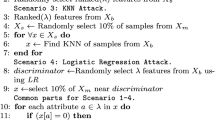Abstract
Adversarial malware examples refer to the malwares that can evade the malware detector. Researching adversarial malware examples can help us find the vulnerability of malware detector and improve the defense ability of cyberspace. Considering the huge market share of android system, adversarial malware examples of android are studied in this paper. And an algorithm is proposed to find universal adversarial perturbations of malware. Such perturbation can be inserted the different malwares to generate adversarial examples. Then the effectiveness of algorithm is verified in the experiment. And three classic android malware detectors are used as targets. Experimental results show that universal adversarial perturbations for different machine learning models can be discovered via the proposed algorithm.
Access this chapter
Tax calculation will be finalised at checkout
Purchases are for personal use only
Similar content being viewed by others
References
Mobile operating systems’ market share worldwide from January 2012 to December 2019. https://www.statista.com/statistics/272698/global-market-share-held-by-mobile-operating-systems-since-2009/. Accessed 16 Apr 2020
Arp, D., Spreitzenbarth, M., Hubner, M., et al.: Drebin: Effective and explainable detection of android malware in your pocket. In: The Network and Distributed System Security Symposium (NDSS), pp. 23–26. ISOC, San Diego (2014)
Mariconti, E., Onwuzurike, L., Andriotis, P., et al.: Mamadroid: Detecting android malware by building markov chains of behavioral models (2016). arXiv preprint, arXiv:1612.04433
Grosse, K., Papernot, N., Manoharan, P., et al.: Adversarial perturbations against deep neural networks for malware classification (2016). arXiv preprint, arXiv:1606.04435
Chen, X., Li, C., Wang, D., et al.: Android HIV: a study of repackaging malware for evading machine-learning detection. IEEE Trans. Inf. Foren. Sec. 15, 987–1001 (2019)
Szegedy, C., Zaremba, W., Sutskever, I., et al.: Intriguing properties of neural networks (2013). arXiv preprint, arXiv:1312.6199
Moosavi-Dezfooli, S.-M., Fawzi, A., Fawzi, O., et al.: Universal adversarial perturbations. In: Proceedings of the IEEE conference on computer vision and pattern recognition, pp. 1765–1773. IEEE, Puerto Rico (2017)
Raff, E., Barker, J., Sylvester, J., et al.: Malware detection by eating a whole exe. In: Workshops at the Thirty-Second AAAI Conference on Artificial Intelligence. AAAI Press, Louisiana (2018)
Kolosnjaji, B., Demontis, A., Biggio, B., et al.: Adversarial malware binaries: evading deep learning for malware detection in executables. In: 26th European Signal Processing Conference (EUSIPCO), PP. 533–537. IEEE, Rome (2018)
Demetrio, L., Biggio, B., Lagorio, G., et al.: Explaining vulnerabilities of deep learning to adversarial malware binaries (2019). arXiv preprint, arXiv:1901.03583
Chen, B., Ren, Z., Yu, C., et al.: Adversarial examples for CNN-based malware detectors. IEEE Access 7, 54360–54371 (2019)
Kreuk, F., Barak, A., Aviv-Reuven, S., et al.: Adversarial examples on discrete sequences for beating whole-binary malware detection (2018). arXiv preprint, arXiv:1802.04528
Madry, A., Makelov, A., Schmidt, L., et al.: Towards deep learning models resistant to adversarial attacks (2017). arXiv preprint, arXiv:1706.06083
Al-Dujaili, A., Huang, A., Hemberg, E., et al.: Adversarial deep learning for robust detection of binary encoded malware. In: 2018 IEEE Security and Privacy Workshops (SPW), pp. 76–82. IEEE, San Francisco (2018)
Labaca-Castro, R., Biggio, B., Dreo Rodose, k.-G.: Poster: Attacking malware classifiers by crafting gradient-attacks that preserve functionality. In: Proceedings of the 2019 ACM SIGSAC Conference on Computer and Communications Security, pp. 2565–2567. Association for Computing Machinery, London (2019)
Hu, W., Tan, Y.: Generating adversarial malware examples for black-box attacks based on GAN (2017). arXiv preprint, arXiv:1702.05983
Hu, W., Tan, Y.: Black-box attacks against RNN based malware detection algorithms. In: Workshops at the Thirty-Second AAAI Conference on Artificial Intelligence. AAAI Press, Louisiana (2018)
Li, H., Zhou, S.-Y., Yuan, W., et al.: Adversarial-example attacks toward android malware detection system. IEEE Syst. J. 1(4), 653–656 (2019)
Rosenberg, I., Shabtai, A., Rokach, L., Elovici, Y.: Generic black-box end-to-end attack against state of the art API call based malware classifiers. In: Bailey, M., Holz, T., Stamatogiannakis, M., Ioannidis, S. (eds.) RAID 2018. LNCS, vol. 11050, pp. 490–510. Springer, Cham (2018). https://doi.org/10.1007/978-3-030-00470-5_23
Castro, R.-L., Schmitt, C., Rodosek, G.-D.: ARMED: how automatic malware modifications can evade static detection. In: 5th International Conference on Information Management (ICIM), pp. 20–27. IEEE, Cape Town (2019)
Suciu, O., Coull, S.-E., Johns, J.: Exploring adversarial examples in malware detection. In: 2019 IEEE Security and Privacy Workshops (SPW), pp. 8–14. IEEE, San Francisco (2019)
Pierazzi, F., Pendlebury, F., Cortellazzi, J., et al.: Intriguing properties of adversarial ML attacks in the problem space. In: 2020 IEEE Symposium on Security and Privacy (SP), pp. 1332–1349. IEEE, San Francisco (2020)
Mao, x., Chen, Y., Wang, S., et al.: Composite Adversarial Attacks. In: Thirty-Fifth AAAI Conference on Artificial Intelligence (AAAI). AAAI, Vancouver, Mao et al. proposed a new composite adversarial attack method, which can automatically search for the best combination of attack algorithms and their hyperparameters from the candidate attacks (2021)
Li, L., Gao, J., Hurier, M., et al.: Androzoo++: Collecting millions of android apps and their metadata for the research community (2017). arXiv preprint, arXiv:1709.05281
Google play. https://developer.android.google.cn/distribute/google-play?hl=zh-cn. Accessed 15 Apr 2020
AppChina. http://www.appchina.com. Accessed 12 Apr 2020
VirusShare. https://virusshare.com. Accessed 16 Apr 2020
Author information
Authors and Affiliations
Corresponding author
Editor information
Editors and Affiliations
Rights and permissions
Copyright information
© 2021 Springer Nature Switzerland AG
About this paper
Cite this paper
Hou, R., Xiang, X., Zhang, Q., Liu, J., Huang, T. (2021). Universal Adversarial Perturbations of Malware. In: Cheng, J., Tang, X., Liu, X. (eds) Cyberspace Safety and Security. CSS 2020. Lecture Notes in Computer Science(), vol 12653. Springer, Cham. https://doi.org/10.1007/978-3-030-73671-2_2
Download citation
DOI: https://doi.org/10.1007/978-3-030-73671-2_2
Published:
Publisher Name: Springer, Cham
Print ISBN: 978-3-030-73670-5
Online ISBN: 978-3-030-73671-2
eBook Packages: Computer ScienceComputer Science (R0)




